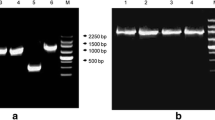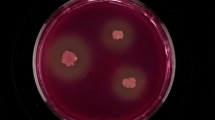Abstract
Cyclodextrin glycosyltransferases (CGTases) are important enzymes in biotechnology because of their ability to produce cyclodextrin (CD) mixtures from starch whose relative composition depends on enzyme source. A multiple alignment of 46 CGTases and Shannon entropy analysis allowed us to find differences and similarities that could be related to product specificity. Interestingly, position 179 has Gly in all the CGTases except in that from Bacillus circulans DF 9R which possesses Gln. The absence of a side chain at that position has been considered as a strong requirement for substrate binding and cyclization process. Therefore, we constructed two mutants of this enzyme, Q179L and Q179G. The activity and kinetic parameters of Q179G remained unchanged while the Q179L mutant showed a different CDs ratio, a lower catalytic efficiency, and a decreased ability to convert starch into CDs. We show that position 179 is involved in CGTase product specificity and must be occupied by Gly—without a side chain—or by amino acid residues able to interact with the substrate through hydrogen bonds in a way that the cyclization process occurs efficiently. These findings are also explained on the basis of a structural model.



Similar content being viewed by others
References
Ahmad S, Gromiha MM, Sarai A (2003) Real value prediction of solvent accessibility from amino acid sequence. Proteins 50:629–635
Astray G, González-Barreiro C, Mejuto JC, Rial-Otero R, Simal-Gándara J (2009) A review on the use of cyclodextrins in foods. Foods Hydrocolloids 23:1631–1640
Blackwood AD, Bucke C (2000) Addition of polar organic solvent can improve the product selectivity of cyclodextrin glycosyltransferase: solvent effects on CGTase. Enzyme Microb Technol 27:704–708
Bowie JU, Lüthy R, Eisenberg D (1991) A method to identify protein sequences that fold into a known three-dimensional structure. Science 253:164–170
Bradford M (1976) Quantitation of microgram quantities of protein utilizing the principle of protein-dye binding. Anal Biochem 72:248–254
Cantarel BL, Coutinho PM, Rancurel C, Bernard T, Lombard V, Henrissat B (2009) The carbohydrate-active enzymes database (CAZy): an expert resource for glycogenomics. Nucleic Acids Res 37:233–238
Costa H, del Canto S, Ferrarotti S, de Jiménez B, Bonino M (2009) Structure–function relationship in cyclodextrin glycosyltransferase from Bacillus circulans DF 9R. Carbohydr Res 344:47–79
Crooks GE, Hon G, Chandonia JM, Brenner SE (2004) WebLogo: a sequence logo generator. Genome Res 14:1188–1190
Eswar N, Marti-Renom MA, Webb B, Madhusudhan MS, Eramian D, Shen M, Pieper U, Sali A (2006) Comparative protein structure modeling with MODELLER. Current Protocols in Bioinformatics. Wiley & Sons, Inc., New Jersey; Supplement 15, 5.6.1-5.6.30.
Ferrarotti SA, Rosso AM, Marèchal MA, Krymkiewicz N, Marèchal L (1996) Isolation of two strains (S-R type) of Bacillus circulans and purification of a cyclomaltodextrin-glucanotransferase. Cell Mol Biol 42:653–657
Goel A, Nene S (1995) Modifications in the phenolphtalein method for spectrophotometric estimation of Beta-cyclodextrin. Starch 47:399–400
Goh KM, Mahadi NM, Hassan O, Rhaman RNZRA, Illias RM (2009) A predominant β-CGTase G1 engineered to elucidate the relationship between protein structure and product specificity. J Mol Catal B: Enzym 57:270–277
Ishii N, Haga K, Yamane K, Harata K (2000) Crystal structure of asparagine 233-replaced cyclodextrin glucanotransferase from alkalophilic Bacillus sp. 1011 determined at 1.9 Å resolution. J Mol Recognit 13:35–43
Janeček S (2002) How many conserved sequence regions are there in the α-amylase family? Biologia Bratisl 57:29–41
Kelly RM, Dijkhuizen L, Leemhuis H (2009) The evolution of cyclodextrin glucanotransferase product specificity. Appl Microbiol Biotechnol 84:119–133
Laemmli UK (1970) Cleavage of structural protein during the assembly of the head of bacteriophage T4. Nature 227:680–685
Laskowski RA, MacArthur MW, Moss DS, Thornton JM (1993) PROCHECK: a program to check the stereochemical quality of protein structures. J Appl Cryst 26:283–291
Leemhuis H, Uitdehaag JCM, Rozeboom HJ, Dijkstra BW, Dijkhuizen L (2002) The remote substrate binding subsite −6 in cyclodextrin-glycosyltransferase controls the transferase activity of the enzyme via an induced-fit mechanism. J Biol Chem 277:1113–1119
Leemhuis H, Kelly RM, Dijkhuizen L (2010) Engineering of cyclodextrin glucanotransferases and the impact for biotechnological applications. Appl Microbiol Biotechnol 85:823–835
Li ZF, Zhang JY, Sun Q, Wang M, Gu ZB, Du GC, Wu J, Chen J (2009a) Mutations of lysine 47 in cyclodextrin glycosyltransferase from Paenibacillus macerans enhance beta-cyclodextrin specificity. J Agric Food Chem 57:8386–8391
Li ZF, Zhang JY, Wang M, Gu ZB, Du GC, Li J, Wu J, Chen J (2009b) Mutations at subsite −3 in cyclodextrin glycosyltransferase from Paenibacillus macerans enhancing α-cyclodextrin specificity. Appl Microbiol Biotechnol 83:483–490
Li ZF, Gu ZB, Wang M, Du GC, Wu J, Chen J (2010) Delayed supplementation of glycine enhances extracellular secretion of the recombinant alpha-cyclodextrin glycosyltransferase in Escherichia coli. Appl Microbiol Biotechnol 85:553–561
Loftsson T, Duchêne D (2007) Cyclodextrins and their pharmaceutical applications. Int J Pharm 329:1–11
Machovič M, Janeček S (2006) Starch-binding domains in the post-genome era. Cell Mol Life Sci 63:2710–2724
Martin del Valle EM (2004) Cyclodextrins and their uses: a review. Process Biochem 39:1033–1046
Park TH, Shin HD, Lee YH (1999) Characterization of the β-cyclodextrin glucanotransferase gene of Bacillus firmus var. alkalophilus and its expression in E. coli. J Microbiol Biotechnol 9:811–819
Parsiegla G, Schmidt AK, Schulz GE (1998) Substrate binding to a cyclodextrin glucanotransferase and mutations increasing the γ-cyclodextrin production. Eur J Biochem 255:710–717
Pettersen EF, Goddard TD, Huang CC, Couch GS, Grrenblatt DM, Meng EC, Ferrin TE (2004) UCSF Chimera—a visualization system for exploratory research and analysis. J Comput Chem 25:1605–1612
Sambrook J, Russell DW (2001) Molecular cloning, a laboratory manual, 3rd edn. Cold Spring Harbor Laboratory, Cold Spring Harbor, NY
Schmid G (1989) Cyclodextrin glycosyltransferase production: yield enhancement by overexpression of cloned genes. Trends Biotechnol 7:244–248
Shindyalov IN, Bourne PE (1998) Protein structure alignment by incremental combinatorial extension (CE) of the optimal path. Protein Eng 11:739–747
Strait BJ, Dewey TG (1996) The Shannon information entropy of protein sequences. Biophys J 71:148–155
Szerman N, Schroh I, Rossi AL, Rosso AM, Krymkiewicz N, Ferrarotti SA (2007) Cyclodextrin production by cyclodextrin glycosyltransferase from Bacillus circulans DF 9R. Bioresour Technol 98:2886–2891
Takada M, Nakagawa Y, Yamamoto M (2003) Biochemical and genetic analyses of a novel gamma-cyclodextrin glucanotransferase from an alkalophilic Bacillus clarkii 7364. J Biochem (Tokyo) 133:317–324
Thompson JD, Gibson TJ, Plewniak F, Jeanmougin F, Higgins DG (1997) The ClustalX windows interface: flexible strategies for multiple sequence alignment aided by quality analysis tools. Nucleic Acids Res 24:4876–4882
Torshin IY, Weber IT, Harrison RW (2002) Geometric criteria of hydrogen bonds in proteins and identification of ‘bifurcated’ hydrogen bonds. Protein Eng 15:359–363
Uitdehaag JCM, Halk KH, van der Veen BA, Dijkhuizen L, Dijkstra BW (1999a) The cyclization mechanism of cyclodextrin glycosyltransferase (CGTase) as revealed by a γ-cyclodextrin-CGTase complex at 1.8-Å resolution. J Biol Chem 274:34868–34876
Uitdehaag JC, Mosi R, Kalk KH, van der Veen BA, Dijkhuizen L, Withers SG, Dijkstra BW (1999b) X-ray structures along the reaction pathway of cyclodextrin glycosyltransferase elucidate catalysis in the alpha-amylase family. Nat Struct Biol 6:432–436
van der Veen B, Uitdehaag JCM, Dijkstra BW, Dijkhuizen L (2000a) Engineering of cyclodextrin glycosyltransferase reaction and product specificity. Biochim Biophys Acta 1543:336–360
van der Veen BA, Uitdehaag JCM, Dijkstra BW, Dijkhuizen L (2000b) The role of arginine 47 in the cyclization and coupling reactions of cyclodextrin glycosyltransferase from Bacillus circulans strain 251. Implications for product inhibition and product specificity. Eur J Biochem 267:3432–3441
Wallner B, Elofsson A (2003) Can correct protein models be identified? Protein Sci 12:1073–1086
Acknowledgments
We thank Drs. J. Delfino, L. Curto, and G. Gómez for performing circular dichroism experiments; Drs. O. Taboga and M.I. Gismondi for their supervision on cloning and sequencing; Lic. S. Linskens and Farm. C. Paván for their technical assistance on mass spectrometry, and Prof. Karen Todel for language supervision. This work was supported by grants from the Universidad Nacional de Luján, Universidad de Buenos Aires, and the Consejo Nacional de Investigaciones Científicas y Técnicas (CONICET). AJD, CMB, and MBJB are career members of CONICET.
Author information
Authors and Affiliations
Corresponding author
Electronic supplementary material
Below is the link to the electronic supplementary material.
ESM 1
(PDF 132 kb)
Rights and permissions
About this article
Cite this article
Costa, H., Distéfano, A.J., Marino-Buslje, C. et al. The residue 179 is involved in product specificity of the Bacillus circulans DF 9R cyclodextrin glycosyltransferase. Appl Microbiol Biotechnol 94, 123–130 (2012). https://doi.org/10.1007/s00253-011-3623-6
Received:
Revised:
Accepted:
Published:
Issue Date:
DOI: https://doi.org/10.1007/s00253-011-3623-6




